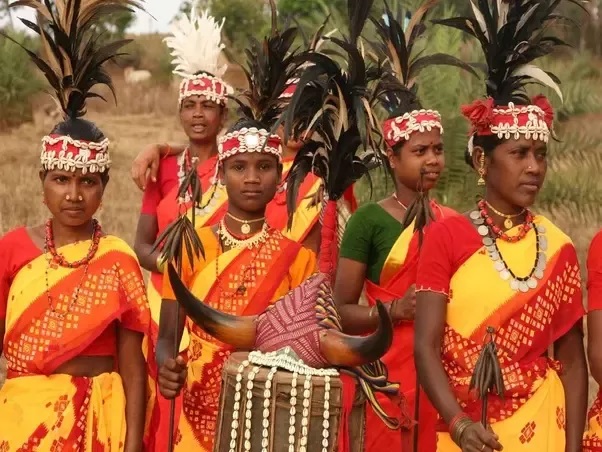Know about Gond Tribe in India & their history: The Gond tribe in India is one of the oldest and most diverse tribal communities in the country. Located mainly in Central and South India, the Gond people are a Dravidian-speaking tribe belonging to Scheduled Tribe or Adivasi category. With a population estimated at around 4 million, the Gond people are one of the largest tribal communities in India.
Know about Gond Tribe in India & their history
- The Gond tribe is an indigenous tribal ethnic group that has been living in central India for centuries. It has a rich cultural heritage and is one of the largest tribes in the country.
- They are believed to have originated from ancient Dravidian or proto-Australoid tribes, who migrated to India over 2000 years ago.
- The Gond people speak their own language, called ‘Gondi’, which is distinct from other languages spoken in the region.
- Traditionally, they were hunter-gatherers and practiced shifting cultivation, but many of them have become settled farmers now.
- Their religious beliefs include animism and ancestor worship. They also believe in karma and reincarnation.
- Women play a very important role in Gond society, with both men and women taking part in decision making for social and family matters.
- One of their most important festivals is called “Mol jam” – it’s an annual festival celebrated at the beginning of spring as a way to invoke rain gods for better harvest prospects.
- Gonds are well known for their artworks such as paintings on walls, floor decorations made of rice powder and coloured sand, wood carvings and metalcrafts. These objects are used not only to decorate homes but also to invoke spiritual powers within their households.
The origin of this ethnic group can be traced back to prehistoric times. Historians believe that they were once part of various ancient civilizations along with other Adivasi tribes like Korku, Bhil and Kolam. Although they have been living in India for centuries, their original homeland remains unknown.
The Gonds practice an animistic religion known as ‘Sarna’ which revolves around nature spirits and ancestor worship. They also worship ‘Marahi’, a pantheon of gods and goddesses which includes figures such as Jhulli Pen, Bada Devi, Jhulka Deo, and more. It is believed that these deities protect them from danger and provide good luck during rituals.
In terms of language, most Gond people primarily speak Odia although some may also know Marathi or Telugu depending on their location. The culture among this ethnic group is rich and colorful; many festivals such as Dussera, Diwali and Pomblangla are celebrated with great enthusiasm every year. Festivals usually involve singing traditional songs associated with their culture while performing rituals to appease the gods and goddesses they worship.
Traditional clothing among Gond people varies greatly depending on location but generally consists of colorful saris for women and lungis for men paired with turbans or headscarves for both genders. Jewelry is also very important within their culture; it’s often made from shell beads or coins strung together with cotton thread into intricate patterns symbolizing strength and power.
In modern times, the Gonds have certainly made progress toward mainstream Indian society but many still struggle with basic amenities such as access to healthcare or education due to their low socio-economic status compared to other groups in India. However, various government initiatives have been put in place over the years to help improve conditions for this marginalized community so hopefully we’ll see progress soon!
History about Gond Tribe
Gond tribe, which belongs to the Dravidian family of tribes, is one of the oldest indigenous tribal communities in India. They are spread across central and eastern India, mainly in Madhya Pradesh, Maharashtra, Chhattisgarh, Odisha and Telangana. The Gonds are known for their unique cultural heritage that has been passed down generations.
The exact point of origin of the Gond people is still unknown but according to legends it is believed that they were part of the ancient Aryan race and had migrated from Central Asia during the second century AD. Their language also shows Indo-Aryan influence in some aspects.
The Gonds have a distinct culture that sets them apart from other tribes in India. With an oral tradition passed down through generations, it includes music, dance, rituals and festivals that celebrates their beliefs and customs. Music plays an important role in their society with instruments like flutes, drums and gungur as well as songs with intricate lyrics that express spiritual matters such as good luck and fortune.
In terms of shelter they mostly live in huts made out of mud or bamboo. They make sure they stay close to nature by using natural resources to provide for themselves like honeycomb harvesting as well as cultivating crops for sustenance. Hunting and fishing also form an integral part of their traditional lifestyle however this has decreased with increased urbanisation in recent years.
Traditionally the Gonds are polytheists who worship multiple Gods including Bhimrao (Deity of Wind), Patesara (Deity of Water) and Mahua (Deity of Flowers). They also practice ancestor worship and celebrate festivals such as Holi, Diwali etc., which revolve around worshipping these deities or spirits associated with them. New Year too is celebrated on different dates across different regions but generally falls between April – June period when harvest season begins.
However since independence much has changed due to government policies meant to uplift the tribal population who still face many issues related to poverty, health care facilities etc., The Indian Constitution too recognises them as Scheduled Tribes meaning special privileges provided by reservation are extended to them so they can lead a more secure life with better opportunities in education as well as employment sector.

